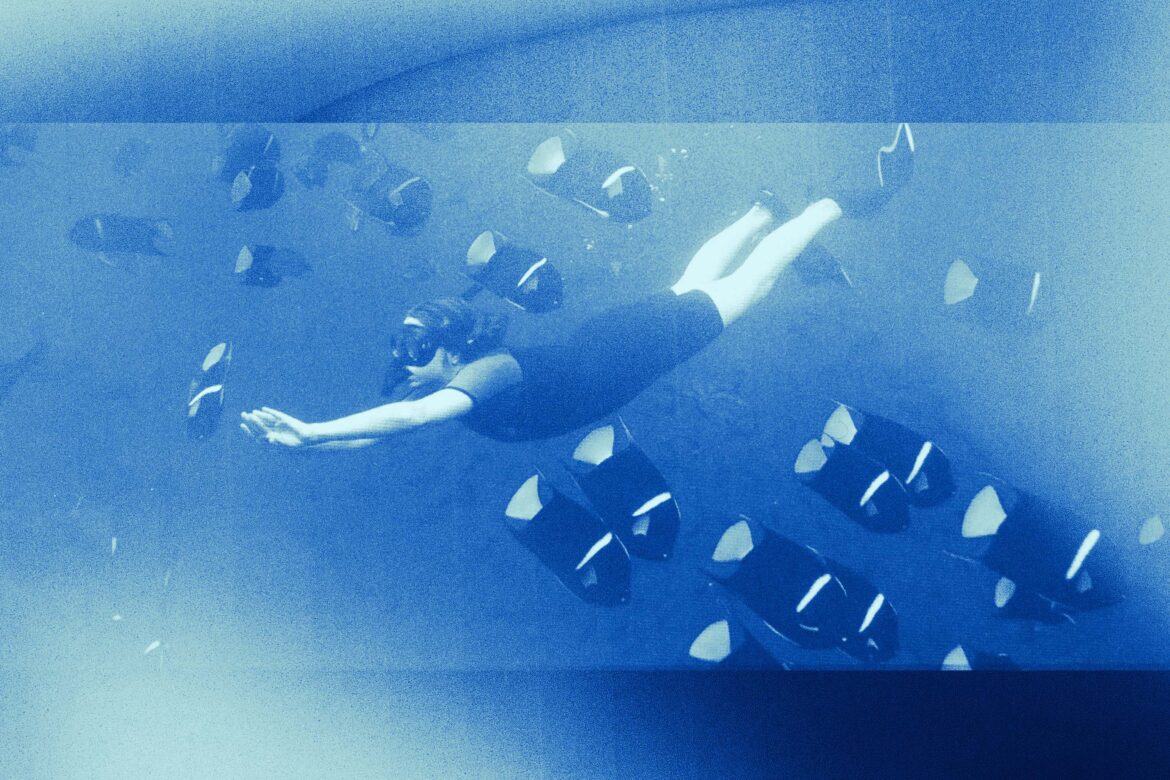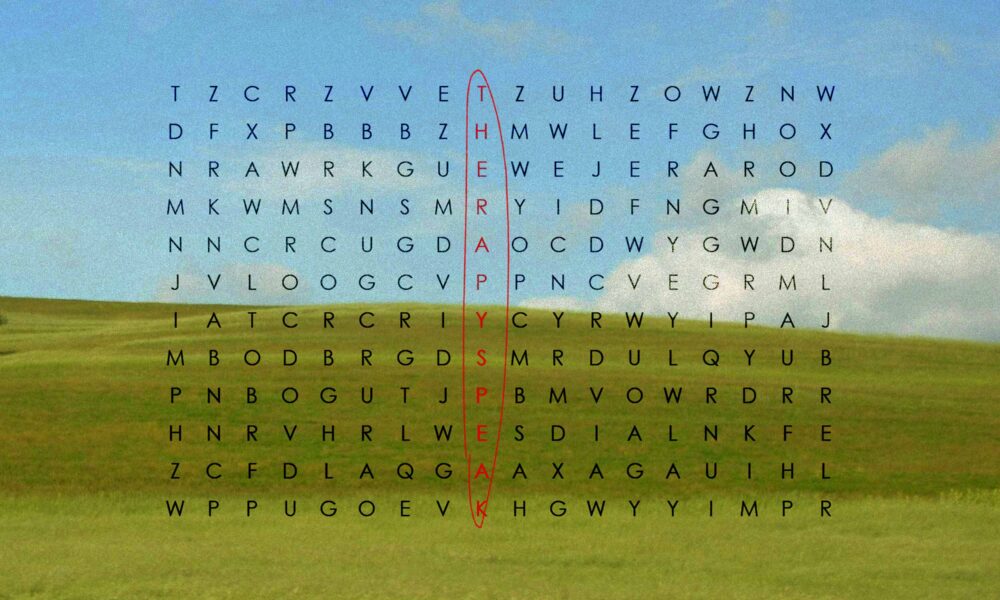Graphic by Antonio Mochmann
In one of the videos on her Instagram feed, Kayleigh Grant swims backwards with the help of her black fins while facing a tiger shark that swims in her direction. It’s clear that they are near the surface, as it is possible to see the waves breaking and a ray of sunlight penetrating through the water. Almost faded in the ocean’s infinite blue, other sharks swim in the distance. Bad Bunny’s song “MONACO” plays in the background. The violin notes fill in the underwater silence.
On the upper left corner of the screen, a message in a small white font reads, “if you panic and swim away from sharks, they will likely continue to follow you due to their prey drive.” When the shark approaches Kayleigh, she stops swimming and — in a swift yet cautious move — pulls the shark’s head down. As soon as her hand touches the shark’s head, the classical violin notes are replaced by a trap beat and another message pops up in the lower right corner, saying, “instead, stand your ground, make eye contact and push them away if absolutely necessary.” The shark swims away.
On Instagram alone, the video has accumulated more than 63 million views and 20,000 comments. A quick search by clicking on the Instagram audio shows that hundreds of people have reposted and reacted to it, making it clear that it has gone beyond the scuba diving “bubble” on the social media platform. She also posted the video on TikTok, where it has more than 25 million views and 17,000 comments.
Kayleigh calls the movement she does in the video “redirecting a shark.” She said that it is essential to understand that, if you take certain actions, there might not even be a need to redirect a shark. For example, just making eye contact with the shark might be enough for it to stay away from you.
“They are very polite predators,” she said. “More than a lot of land animals.”
If that — in addition to staying calm and not splashing — doesn’t work, she recommended putting something like a fin or a surfboard between you and the animal. However, if you end up having no other option but redirecting the shark, she explained that you should place your hand on the top of the head, keep your arm “really really” stiff to make sure your body is at an arm’s length from the shark and, if you are really scared, target the gill area, as it is more sensitive.
“A lot of people think you just need to punch it, but, if you’re just punching something, your hand could end up hitting the mouth,” she said.
Kayleigh is a professional shark diver who owns an ocean safari business called Kaimana Ocean Safari in Kona, Hawaii. She is also an influencer with more than 300,000 followers on Instagram and more than 2 million on TikTok.
Kayleigh began casually posting on Instagram around 2017, hoping to show the beauty of Hawaii. She reached 30,000 followers at the time. In 2020, she started her business. She found herself with more free time as business was slow — she couldn’t take tourists out to the ocean during a global pandemic. That was when she ventured into making videos for TikTok. Her profile soon blew up. In a matter of two years, she reached 2 million followers.
“It’s been a really cool journey,” she said.
Upon visiting her social media pages, users are greeted with vibrant blue, aquamarine, white and green color palettes. Scrolling through her feed is like being teleported into an underwater world: there are videos of her redirecting sharks, pictures from her trip to Belize, clips of her diving with whales and shots of her “strolling” through the seagrass. Her content is an escape for avid scuba divers or marine life lovers who are confined within the walls of tiny apartments. It can also serve as an educational resource for those who are unfamiliar with the ocean and the creatures that inhabit it.
In a world where humans kill an estimate of 100 million sharks every year, creating an emotional connection between sharks and humans is vital. There are nearly 520 shark species on the planet. More than one third of these species are at risk of extinction. Shark-like animals have inhabited Earth’s oceans for 450 million years. Over the past 50 years, shark populations in the open ocean have decreased by 71%.
Sharks help the ecosystem by “cleaning” it. They eat injured and sick fish, keeping populations under control. Additionally, sharks affect prey distribution, as prey species avoid habitats where they might be eaten by sharks — a pivotal process to maintain the health of marine habitats. Moreover, as a species, sharks aren’t a threat to humans, as fewer than 10 people are killed by sharks every year.
With her videos, Kayleigh aims to “show sharks in a different light” and make people love them.
“As humans, we protect what we love,” she said.
Kayleigh’s love for the ocean bloomed when she was a child growing up in a small town in the outskirts of Philadelphia, Pennsylvania, in the era of The Little Mermaid and Free Willy. She would go on vacations with her mother to the New Jersey shore, and whale watching with her father off the coast of Massachusetts.
“If you asked me when I was young what I wanted to be, my true answer would be that I wanted to be a mermaid,” she said.
Kayleigh credits her father Tim Burns as the one who fostered her passion for the ocean. Burns still lives in Pennsylvania. Remembering his first trip with Kayleigh to Massachusetts — which happened around 25 years ago — he said that the animals put on “such a display,” as dolphins swam underneath the boat and whales were feeding everywhere. None of them could believe the extraordinary amount of wildlife out there.
“I think [Kayleigh] was hooked that day,” he said.
Burns decided to take her on the trip after they watched Free Willy. At the end of the movie, there are instructions on how to “adopt” a whale and 10-year-old Kayleigh was “pretty persistent” — so they did it. The adoption consisted of a certificate and a donation to whale preservation.
He realized Kayleigh’s love for the water early on. They had a pool in the backyard she had been swimming in since she was 1 year old. He recalled that many summers were spent in that backyard, where Kayleigh would hang out with her friends from down the street and have her birthday parties every year.
However, Kayleigh said that, as she moved on to high school and college, the world taught her that what your imagination tells you isn’t always true. She realized it wasn’t possible to be a mermaid. Instead, she had to get a good job, save for retirement and buy a house.
Kayleigh attended Temple University, where she earned a degree in ecotourism. After graduating, she found herself struggling with mental health. She no longer wanted to be on track to live a stereotypical life.
“It was important to find again what I really loved out of life,” she said.
She packed up her life and moved to Hawaii in 2012 to begin a waitressing job with $3,000 in her bank account. She didn’t know what was next — she could stay there for three months or three years. All she knew was that she wanted to go back to the ocean.
Moved by that desire, she began scuba diving in 2013, eventually getting a dive master certification in 2014. In 2015, she completed a Marine Option Program offered by the University of Hawai’i, for which her final project was on shark photo identification. That was when she started working directly with sharks. In 2020 — after getting a captain license and a free diving certification — she created her business with her husband, Cam Grant.
Originally from Denver, Colorado, Cam moved to Hawaii — which he refers to as the Hawaiian Islands — in 2013, looking to reset after four years in California serving as a combat engineer in the U.S. Marines. He met Kayleigh in 2016 through mutual friends in the diving community. Cam shared that he already had some knowledge of Kayleigh’s job and was looking forward to learning more about it. He said that everything “unfolded naturally” after they met. Kayleigh confirmed that, saying that they knew right away they were each other’s person.
“We haven’t spent a day apart ever since,” he said.
Cam’s scuba diving career was nonexistent — until he met Kayleigh. She introduced him to ocean exploration through scuba diving. Soon after meeting her, he began taking lessons.
At the time, they were working for separate companies. She was starting a job as a shark diver while he was working on a boat called Dolphin Excursions. When they created Kaimana Ocean Safari, they thought it was important to introduce people to “everything” out in the ocean, rather than focus on one species. The idea was to combine a safari aspect with a shark-diving front.
On a regular day, Kayleigh and Cam wake up around 6 a.m. and go straight to pick up their guests and set up the boat. Then, they go out in the ocean to look for wildlife, which, for Kayleigh, is the fun part.
“Having the possibility of anything happening that day and every day being completely different really makes my life more exciting,” she said.
Cam explained that they always start tours giving guests an overview of vessel safety, which is followed by an elaborate briefing to make guests feel more comfortable. This briefing includes information on the areas that they will cover, the depth that they will be at and which animals can be seen. Finally, they go into more details about each species and, if they come across a species, they do another briefing.
“That way everyone is aware of their safety,” he said.
They normally do one or two tours a day. After getting home, they play with their dog Mako, an energetic Australian shepherd border collie mix. They typically cook dinner together and go to bed around 8 p.m.
Cam said that one of the things he loves the most about working with Kayleigh is her ability to share the ocean with others, which leads to an interest in it and a sense of care. He also emphasized that the education she brings to the table is very valuable.
“Kayleigh is extremely driven,” he said.
Kayleigh said that working with your partner isn’t for everyone, but it works for them. She added that they have the kind of relationship in which they do almost everything together and that they balance each other out very well. She explained that he is kind, patient and humble and that she brings the spice to their lives with her wild dreams.
“With my head on the clouds and his feet on the ground, we make it work,” she said.
She didn’t deny the struggles and said that starting the business was the greatest challenge they faced as a couple. But, reflecting on what they accomplished in the past years, she could only feel amazed.
Regarding the past, Kayleigh said that one of the first things that they did together was take pictures of the ocean. Cam eternalized in a picture what she calls the most special moment she has ever had with a shark: an interaction with a 22-foot great white shark in 2019 as it was eating a dead sperm whale.
“It was beautiful, which people would probably think that I’m crazy to say,” she said, smiling widely. “[The shark] was probably pregnant, so this great white was way more docile, calm demeanor than other great whites would be.”
The picture hangs on the wall behind her and is also her profile picture on social media. It’s stunning. Kayleigh floats vertically next to the great white, caressing it with her left hand and holding a tiny camera with her right hand. Her blonde hair is tied in a short braid and her body leans towards the shark’s belly, her fins flipping to maintain balance. While her right leg is bent, her left is stretched out. It’s not possible to see her eyes, as they are hidden by the border of her mask, but she seems to be looking at the visor of her camera. Her diving suit is black and blue. The shark, which is at least three times the size of Kayleigh, gazes away into the ocean, its mouth open. Above them, perhaps the most interesting detail, the sun paints their reflection in the water, creating a mirror effect.

Cam said that the picture was taken about 10 nautical miles out of the island of O’ahu. He remembered that the sperm whale was floating with her belly up, serving as a food source for many species. They noticed that there were several tiger sharks and, before jumping into the water, evaluated that the situation was safe. Kayleigh and another man jumped first while Cam stayed on the boat. After a while, the sperm whale attracted a great white, which they distinguished directly because of its pointed nose.
Cam was still in the boat when he heard about the great white. He slipped into the water with his camera equipment and took some of the best pictures of his career.
“My heart was beating through my chest,” he said, laughing afterwards.
He emphasized that, whenever he jumps in the water with Kayleigh, there’s always a sense of safety, as she brings a lot of light to the ocean. Moreover, he said that she isn’t only passionate about the ocean — she is also passionate about the people around her, taking the extra mile to take care of who she loves.
“She has the most beautiful soul,” he said.
Lori Sippoos can attest to that. She has known Kayleigh since they were 18 years old. Although they went to high school together, they only became friends in college through one of Kayleigh’s ex-boyfriends.
“One of the first times we hung out, we were actually beer-pong partners together,” she said.
Ever since Kayleigh moved to Hawaii, Sippoos was a frequent visitor. Throughout her visits, she grew a love for the islands. However, as a worker in the pharmaceutical industry, Sippoos never thought she would have the opportunity to live somewhere like Hawaii, where there is no pharmaceutical manufacturing. After Sippoos quit her job in April 2021, Kayleigh encouraged her to revisit her old desire to live in Hawaii. Sippoos moved to the island of Kona in 2022.
Kayleigh encouraging her to move to Hawaii is an example of what Sippoos considers one of Kayleigh’s greatest qualities as a friend: she helps people reach their full potential.
“When you need tough feedback, she will give it to you,” Sippoos said.
Perhaps this part of Kayleigh’s personality is what allowed her to thrive on social media. Like any influencer, Kayleigh has gotten hate in the past. In her case, she received comments calling her stupid and reckless, some of them even bringing up her physical appearance. Most of these comments come from men, she said. She imagines that seeing a woman swimming alongside one of the world’s top predators can be very triggering for a man who knows he wouldn’t have the courage to do so.
“Fishermen get pretty triggered when they see us speaking up for sharks,” she added.
Commercial shark fishing is a big threat for sharks around the world. In the United States, commercial shark fishers use techniques that allow them to catch large quantities of sharks to be sold. This leads to overfishing, the process of taking fish out of the ocean at higher rates than what they can reproduce. On a smaller scale, sharks can also be victims of recreational fishing, in which sharks are often used as trophies.
Regarding negativity, Kayleigh has a message for the readers.
“Just ignore the haters,” she said.
Kayleigh is a firm believer that hate says more about the other person than about herself. She stressed that there will always be haters.
“People just want to hate these days,” she said.
But she doesn’t let that affect her self-love.
Kayleigh didn’t become a mermaid like she wanted to. That’s obvious, mermaids don’t exist. However, she is an explorer of the planet’s oceans, swimming daily with some of the Earth’s most enchanting creatures. She goes beyond interacting with sharks, dolphins and whales. She understands that she is sharing a space with them and respects them. And above all, she tries to make others love them.So, even though mermaids don’t exist outside of fantasy stories, Kayleigh got the closest she could to becoming one. And, along the way, she became an influencer, showing her followers the beauty of diving with these majestic animals. Kayleigh is a mermaid influencer, carrying the title in her social media username: @mermaid.kayleigh. She knows that the people who believe in her mission will find her. Millions of them already have.




Comments are closed.